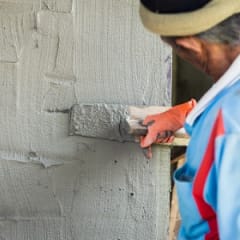The Ultimate Guide To Plasterer
Wiki Article
Plasterer for Beginners
Table of ContentsA Biased View of PlastererNot known Facts About PlastererUnknown Facts About PlastererPlasterer Things To Know Before You Get This
After the work location is floated, the surface is completed with a wet sponge using the same technique as floating with a wood float, bringing sand to the surface to give a smooth consistent finish. Materials used in the make are frequently neighborhood sands with little clay web content with penalty to rugged grains.Plasterers make use of a t-bar to screed the wall surfaces till it is plumb, straight and square. 2 coat transcends as, although extra costly, it provides a more regular finish and also has much less chance of becoming drummy or cracking. Drumminess happens when the make doesn't bond entirely with the wall surface, either because the wall surface is also smooth, a layer is too thick, or the coat is being drifted when the make has hardened excessive, leaving an air area that makes a drumming audio when a metal device is "scrubed" over it.
Instead of being ended up with a sponge, the 2nd coat is left rough as well as often will certainly be scored by nails placed in the float. After drying out, the surface area is then scuffed to remove loosened grains of sand before smudging. If the walls are concrete, a splash layer is needed to guarantee bonding.
Special blends are in some cases needed for architectural or functional reasons.
The Best Strategy To Use For Plasterer
The miters at the angles are ended up off with joint regulations made of sheet steel of various lengths, 3 or 4 inches (102 mm) vast, and about one-eighth inch thick, with one end cut to an angle of about 30. Sometimes the steel plate is allow right into a stock or manage of wood.
The contemporary use this product may be said to have actually started then, however making use of coarse plaster was known and also exercised by the Egyptians long before the Christian period; for ancient caskets as well as mommies still maintained show that linen tensed with plaster was used for enhancing coffins as well as making masks.
Canvas and mortar were in basic use in Great Britain as much as the center of the 20th century. This work is also much utilized for momentary job, such as exhibition buildings. There are 2 major methods in U.S.A. used in building of the interior walls of contemporary residences, plasterboard, also called drywall, as well as veneer plastering.
8 Easy Facts About Plasterer Described

At the location where both sides of wallboards fulfill there is look what i found a joint. These seams are covered with mesh tape and afterwards the joints as well as the screw heads are hidden with the drywall substance to make the wall appear as one attire piece. The drywall plaster is a thick paste.
This procedure is commonly called "taping" and also those pop over to this site that utilize drywall are referred to as "tapers". Veneer gluing covers the entire wall with slim liquid plaster, uses a terrific deal of water and is applied really damp. The wall surfaces meant to be glued are hanged with "Blueboard" (called thus for the sector criterion of the outer paper being blue-grey in color).
Veneer plastering is a one-shot one-coat application; taping generally needs fining sand and after that including another layer, since important site the substance reduces as it dries (Plasterer). The plasterer typically turns up after the wall mounts have completed developing all the interior wall surfaces, by connecting blueboard over the frames of your home with screws. The plasterer is usually a subcontractor functioning in crews that balance about 3 veterans and also one laborer.
Particles left on the floors from the "dangling" crew need to be removed before flooring paper can be put down and to eliminate any kind of tripping hazards. Cover the floors with tar or brown paper considering that plaster can tarnish or be hard to eliminate from subflooring plywood. Run hoses and also expansion cords as well as established work lights.
The 5-Second Trick For Plasterer
Establish for the following mix. As quickly as the table is gotten rid of the laborer is given directions of the amount of bags will certainly be required as well as the next room to be worked in. The table normally includes folding legs whereupon is set a square board of wood and then covered in a plastic sheet upon which the plaster is put in the facility in a huge heap.The blending barrel is generally pre-filled to a certain level with water; because it can take a while to load (Plasterer). The quantity of water is usually approximated (with a margin of mistake leaning towards too little). The amount of water required is obtained from the amount of bags planned to be mixed.
With an irreversible crew that normally does the very same amount per mix one can just fill up the barrel to a recognized cut-off point. As soon as the mix is established up and also the plasterers are all set they instruct the laborer to begin discarding the bags in the water barrel, while periodically running the blending drill.
At a particular point prior to the blending is done a margin trowel is again made use of to scuff any clinging completely dry plaster into the rest of the mix. typically this is when the accelerator; if made use of is added - Plasterer. Mixing can be fatigueing because the drill tends to not just be heavy yet the mixer needs to also deal with the torc of the paddle.
Report this wiki page